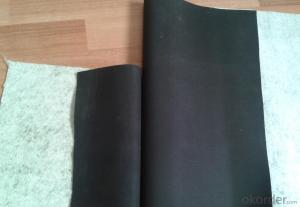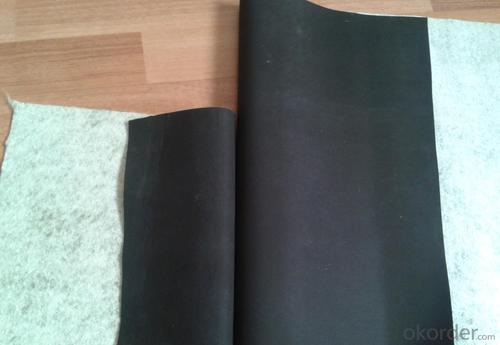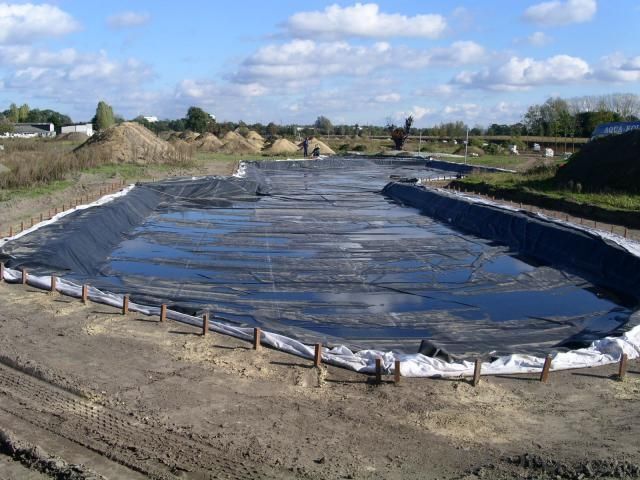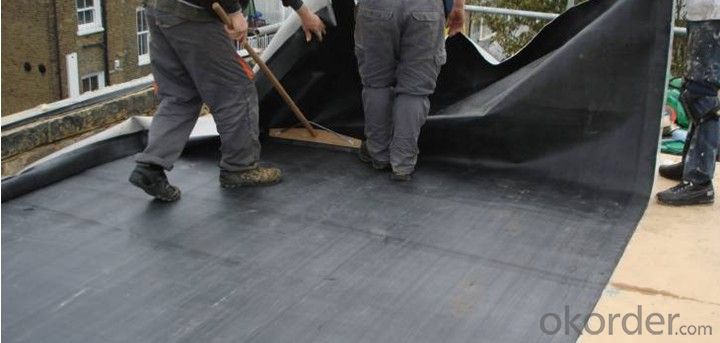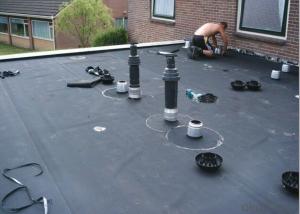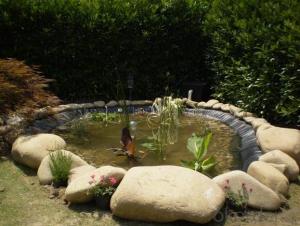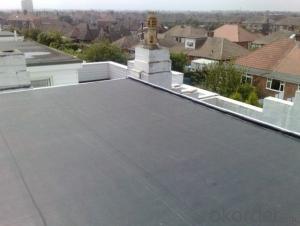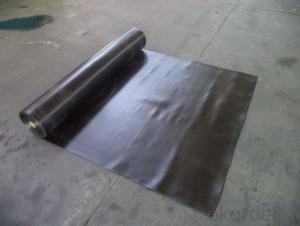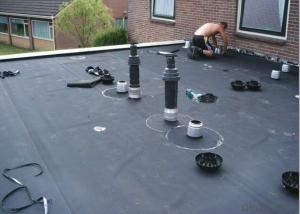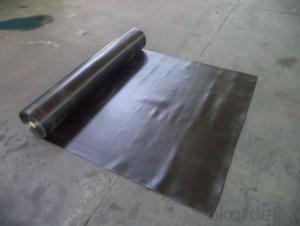EPDM Rubber Coiled Waterproof Membrane with Special Treatment
- Loading Port:
- Shanghai
- Payment Terms:
- TT OR LC
- Min Order Qty:
- 50000 m²
- Supply Capability:
- 5000000 m²/month
OKorder Service Pledge
OKorder Financial Service
You Might Also Like
EPDM Rubber Coiled Waterproof Membrane with Special Treatment
Description Of EPDM Rubber Coiled Waterproof Membrane with Special Treatment:
•EPDM waterproof sheet has excellent anti-ozone-aging performance, able to resist ultraviolet light and corrosion of many chemical corrosive materials in the atmosphere
•It has high tensile strength, high ductility and strong retractility, it has excellent crack resistance, able to effect waterproof function even with tiny vibration of buildings.
• Excellent resistance to ozone, oxidation and sunlight.
• Resistance to chemicals; resistant to most inorganic products.
Main Features of EPDM Rubber Coiled Waterproof Membrane with Special Treatment:
1>Excellent antiaging performance, service life up to 50 years
2>Working well with in 40C to 100C,it canbe constructed with a single layer in ambient temperature.
3>Waterproofing on various kinds of underground project,industrial of civil buildings and structures.
4>high extension rate, high tensile strength, small size changes at heat treatment
5>Good plant roots penetrability resistance and can be made waterproofing layer of planting roof
6>Special modified molecular structure ,effectively resolving the current domestic and foreign glue joint problem.
7>Good low temperature flexibility, and good performance of adapting to ambient temperature changes.
8>Convenient application ,solid joint, no environment pollution
9>chemical corrosion Resistance, can be used for special occasions
10>Convenient maitenance, low cost.
Specifications of EPDM Rubber Coiled Waterproof Membrane with Special Treatment:
| Material | EPDM Rubber |
| Size | 1.2m (width)*20m (length) or customized, weldable type 2.05m or 4m width |
| Thick | 1.2mm, 1.5mm, 2.0mm |
| Type | Vulcanized & Weldable |
| Pattern | Non-reinforced (homogeneous) |
| Certificate | ISO9001/14001 |
Applications of EPDM Rubber Coiled Waterproof Membrane with Special Treatment:
Widely used in roofs, basement, toilet ,swimming pool, and all kinds of industry and civil building waterproofing, reservoir, vivicism, bridge, underground, tunnel and dam waterproofing ,especially to the keystone waterproofing projects which is durability, high corrosion resistance and easy deformation.



IMages of EPDM Rubber Coiled Waterproof Membrane with Special Treatment:




FAQ of EPDM Rubber Coiled Waterproof Membrane with Special Treatment:
1. What are we supplying?
We are specialized in producing Colorful Asphalt Roof Shingle, SBS/APP modified bitumen waterproof membrane, Self adhesive bitumen waterproof membrane, PVC waterproofing membrane, EPDM rubber roofing membrane, Single Component Polyurethane Waterproof Coating, and Spray Polyurea Waterproof Coating
.
2. How Many years experience do we have?
We have been exported to more than 20 countries in the past 15 years.
3. How long do we usually reply your request?
We always reply our customer within 24 hours.
- Q: The difference between high polymer modified asphalt waterproofing membrane and sbs
- SBS modified asphalt waterproofing membrane is a kind of polymer modified asphalt waterproofing membrane, which is included with the included relationship.
- Q: Are waterproofing membranes suitable for underground parking garages?
- Yes, waterproofing membranes are suitable for underground parking garages. They provide an effective barrier against water infiltration, preventing damage to the structure and protecting against potential leaks and moisture-related issues. Waterproofing membranes are designed to withstand the high water pressure typically associated with underground environments, making them an ideal solution for ensuring the longevity and durability of underground parking garages.
- Q: Can a waterproofing membrane be used in renovation or retrofitting projects?
- Certainly, a waterproofing membrane is a viable option for use in renovation or retrofitting endeavors. In fact, it often plays a crucial role in these projects, guaranteeing the long-term resilience and safeguarding of the building or structure. Waterproofing membranes are specifically designed to establish a barrier against moisture infiltration, effectively thwarting water damage, mold proliferation, and structural decay. When engaging in renovation or retrofitting tasks, it is not uncommon to encounter predicaments such as leaks, cracks, or deteriorated building materials that undermine the building's waterproofing system. In such scenarios, the application of a waterproofing membrane over the affected areas proves to be a reliable method of sealing and protecting them from further harm. This can be accomplished both internally and externally, tailored to the specific requirements at hand. Waterproofing membranes are available in a variety of forms, including sheet membranes, liquid coatings, or spray-applied membranes. They can be employed on various surfaces such as roofs, walls, basements, and even foundations. These membranes possess qualities such as flexibility, durability, and resistance to water and other environmental pressures, rendering them exceptional for renovation or retrofitting undertakings where augmenting the building's waterproofing capabilities is imperative. In conclusion, it is highly advisable to incorporate a waterproofing membrane into renovation or retrofitting ventures to ensure the endurance and integrity of the building. It serves as a proactive measure to preclude future water damage, preserve structural stability, and enhance the overall quality of the revitalized or retrofitted space.
- Q: Are waterproofing membranes resistant to acid rain?
- Yes, waterproofing membranes are generally resistant to acid rain. Waterproofing membranes are designed to provide a barrier against water penetration, and they are typically made from materials that are resistant to various environmental factors, including acid rain. Acid rain is caused by the emission of sulfur dioxide and nitrogen oxide pollutants, which react with water vapor in the atmosphere to form sulfuric and nitric acids. These acids can corrode and damage certain materials over time, but waterproofing membranes are specifically engineered to withstand acid rain and other environmental stresses. They are commonly made from materials such as modified bitumen, thermoplastic polyolefin (TPO), ethylene propylene diene monomer (EPDM), or polyvinyl chloride (PVC), which have high resistance to acid rain. Additionally, some waterproofing membranes may have additional protective coatings or additives that enhance their resistance to acid rain, ensuring long-term durability and performance. However, it is important to note that the exact resistance level of a waterproofing membrane to acid rain may vary depending on the specific product and manufacturer, so it is always recommended to consult the manufacturer's guidelines or specifications for accurate information.
- Q: Can a waterproofing membrane be used for a plaza deck?
- Indeed, a plaza deck can utilize a waterproofing membrane. A plaza deck, typically raised and subject to diverse weather conditions like rain, snow, and sunlight, necessitates the use of waterproofing membranes. These membranes are specifically designed to act as a shield against water intrusion and safeguard the underlying structure against moisture-related harm. They are commonly employed in outdoor settings, including plaza decks, with the aim of averting water seepage into the building or structure below. The installation of a waterproofing membrane on a plaza deck not only guarantees the deck's endurance and resilience but also offers pedestrians a secure and dry environment.
- Q: Can a waterproofing membrane be used on brick surfaces?
- Yes, a waterproofing membrane can be used on brick surfaces. The membrane can be applied to protect the brick from moisture, water infiltration, and potential damage caused by water absorption.
- Q: Can a waterproofing membrane be used on tunnels with emergency exits?
- Yes, a waterproofing membrane can be used on tunnels with emergency exits. In fact, it is highly recommended to use a waterproofing membrane in such tunnels to prevent water infiltration and protect the structural integrity of the exits. Waterproofing membranes are designed to create a barrier against water and moisture, ensuring that the tunnels remain dry and free from water damage. This is especially important for emergency exits, as they need to be accessible and functional at all times. By installing a waterproofing membrane, the tunnels can be effectively protected from potential water ingress, ensuring the safety and usability of the emergency exits.
- Q: Can a waterproofing membrane be exposed to sunlight?
- Yes, a waterproofing membrane can be exposed to sunlight. In fact, many waterproofing membranes are designed to withstand prolonged exposure to sunlight without deteriorating or losing their effectiveness. However, it is important to note that not all waterproofing membranes are equally resistant to UV rays, so it is crucial to choose a membrane that is specifically designed for outdoor use and can handle exposure to sunlight. Additionally, it is always recommended to follow the manufacturer's instructions and guidelines for the specific waterproofing membrane being used to ensure its longevity and performance.
- Q: Can a waterproofing membrane be applied in cold weather conditions?
- Applying a waterproofing membrane in cold weather is possible, but the temperature range may differ depending on the product and manufacturer guidelines. Certain membranes can endure cold temperatures and be applied as low as -20 degrees Celsius (-4 degrees Fahrenheit), while others may have a higher minimum application temperature. Following the manufacturer's instructions is crucial, as well as ensuring the surface is adequately prepared and free from ice, snow, or moisture. Consulting with an experienced professional contractor who has worked with waterproofing membranes in cold weather conditions is also recommended for optimal results.
- Q: Can a waterproofing membrane be used on terrazzo surfaces?
- Terrazzo surfaces can indeed benefit from the application of a waterproofing membrane. Terrazzo, a strong and adaptable flooring material composed of marble, granite, quartz, or glass chips mixed with cementitious or epoxy matrix, has a moderate resistance to water. However, it is not entirely impervious and can absorb moisture if not treated. To safeguard against water damage, staining, and discoloration, it is recommended to apply a waterproofing membrane on terrazzo surfaces. The membrane functions as a barrier, effectively preventing water and other liquids from penetrating the terrazzo, thereby enhancing its durability and maintaining its aesthetic appeal. To ensure optimal effectiveness, it is crucial to choose a waterproofing membrane that is compatible with the terrazzo material and follow the manufacturer's instructions during application.
Send your message to us
EPDM Rubber Coiled Waterproof Membrane with Special Treatment
- Loading Port:
- Shanghai
- Payment Terms:
- TT OR LC
- Min Order Qty:
- 50000 m²
- Supply Capability:
- 5000000 m²/month
OKorder Service Pledge
OKorder Financial Service
Similar products
Hot products
Hot Searches
Related keywords
